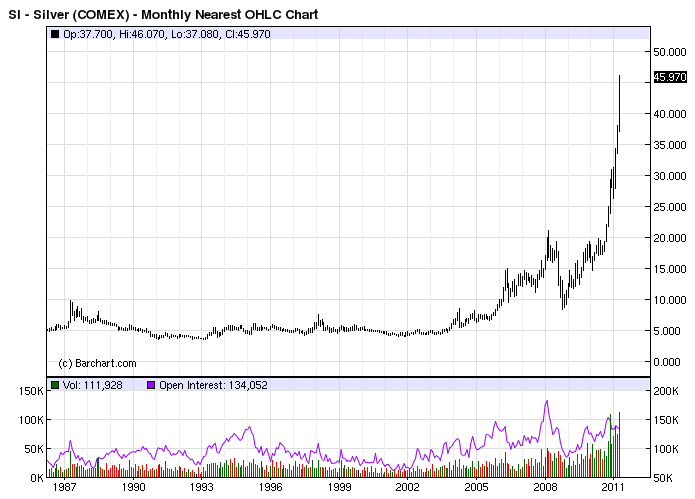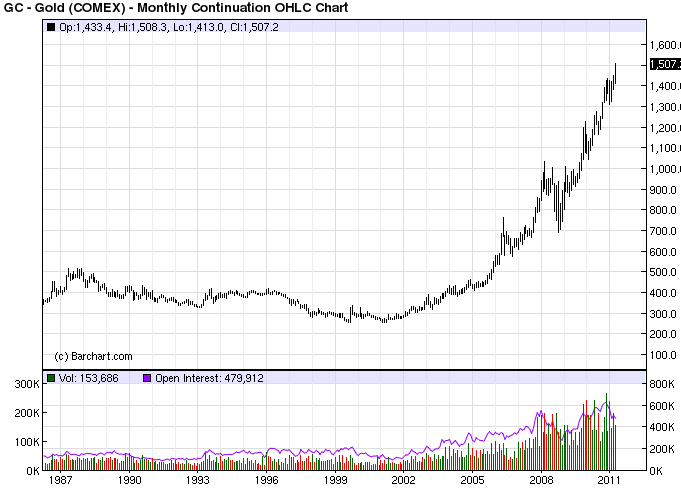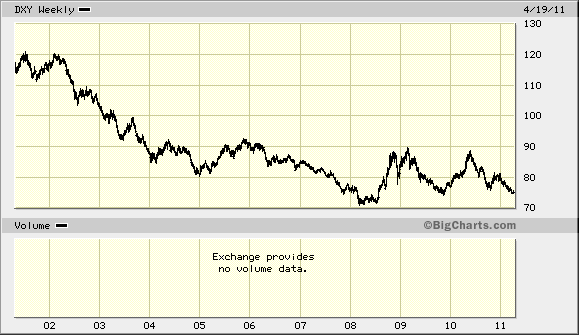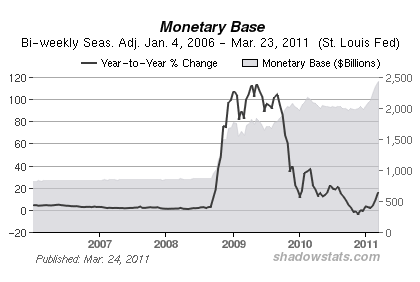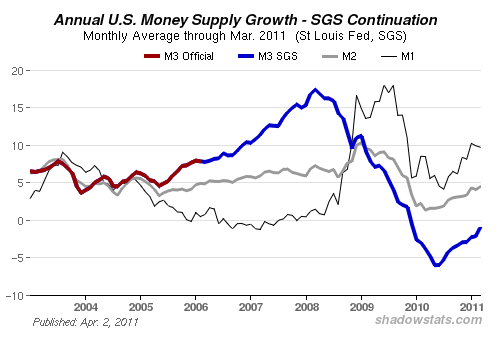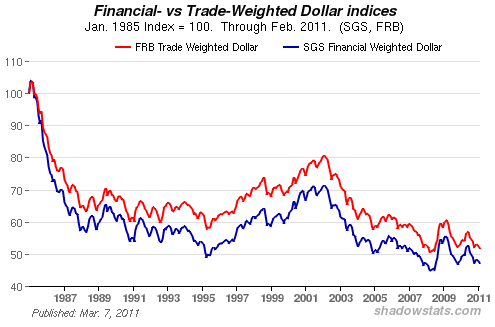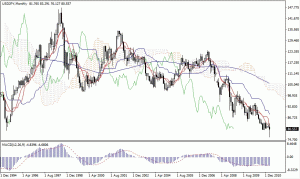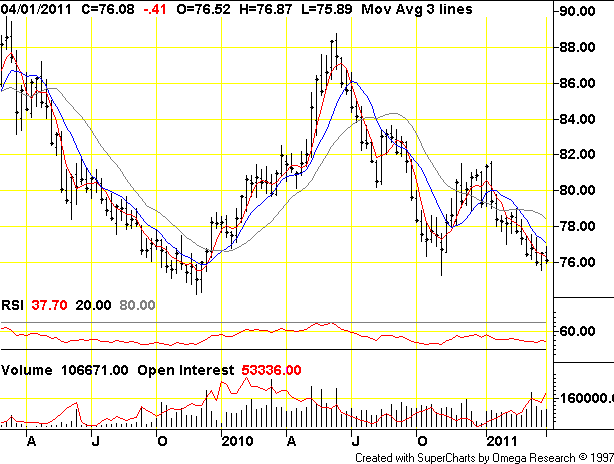Sorry for my long hiatus from blogging. I’ve been trading very little over the last six months, demoralized and righly so due to chronically awful trade execution and overreaching. I have a highly valid reversal strategy, but it is not a trend strategy, and I need to keep my bearish macro views out of the equation (though I suspect that they would be better suited to the next 2 years that the last 2 – but I need to forget about that and keep such discussions academic, for risk of corrupting a perfectly good trading model).
I’ve done some soul-searching and review of my trading history and this blog, and come to the conclusion that I should not abandon this pursuit but instead work to remedy my fatal flaws. A review of my history shows that I am able to identify turns in markets with a very high degree of probability. The fatal flaws are not analytical, but as is usually the case, emotional and procedural. This blog actually has a very good record of both initiating positions and closing or reversing them. As a trader, I would have done well to follow its advice, but I would often revert back to my bear bias, and way too soon, as when I shorted risk last March-April, booked huge profits and went long (including buying bottom tick in EUR and CHF) in June, only to reverse and go short again in July on bias alone without my proven criteria for a valid set-up.
My basic methodology as it has evolved here since August 2008 when this blog began, is to use sentiment and technical data to identify oversold and overbought conditions that are long in the tooth and due for clearing reversals.
The classic set-up is like this:
- DSI sentiment has plateaued or bottomed at an extreme (<20% or >80% for at least 5 weeks, the longer the better – this can go on for 6 months at the outside, more commonly 4-12 weeks if we are talking <20% or >80% readings).
- A major move comensurate with that sentiment has occurred (the market is trading at highs or lows), which to the mass of traders seems totatally justified by fundamentals.
- Price action shows weakening momentum. This is indicated by a diverging trend in oomph indicators MACD and RSI. This usually means that the rate of change is slowing and that each new little push is slower and on lower volume, even as new extremes in price are reached.
- A loose stop-loss level can be identified (a level that should it be broken decisively, would indicate that the prevailing trend still has legs). This is a mult-week strategy, so stops should use daily or even weekly levels — no use for 5 minute charts here.
- Markets are highly coordinated in recent years. E.g., if the dollar is looking like it is going to rally, don’t be long stocks or commodities or short bonds.
- Adjust stops downward to breakeven after the reversal, and tighten stops to a gain as DSI data reaches 40-60% middle ground.
- Tighten stops much more or close positions after DSI data approaches the opposite extreme (e.g., if you shorted SPX when DSI bulls were 90%, prepare to close and consider the trade finished once DSI reaches 25%).
- This is not a trend system! Repeat, this is not a trend system! Trade reversals only, as those have the highest probability. Once the oversold/overbought condition is cleared, the probability of the market continuing in your direction is vastly lower, and does not justify the risk (no matter your opinion of the longer-term situation or fundamentals). This last point was my fatal flaw.
So, we have a classic long-dollar set-up developing right now. I give it strong odds that we experience a major dollar rally within 2 months, with all of the de-leveraging that entails in other markets. This is not the place to put on a heavy position if you are not willing to accept big drawdowns, since this market could easily trend for a while yet, with the stock markets holding up as well.
-
source: futures.tradingcharts.com
-
Note that this trade is confirmed by the opposite in the stock market. Plateau in DSI and other sentiment indicators at a high level of bullishness for several weeks. This condition will be cleared to the downside as the dollar breaks upward. Copper, oil, etc will also correct hard down, and the anti-dollar currency pack (CAD, GBP, EUR, AUD and probably CHF) will fall as well. Not sure about JPY – it often trades up with the dollar during these little episodes of risk unwinding.
.
As always, the timing is the most uncertain factor here, but the longer the dollar sentiment stays low, the less risk there is in this trade and the stronger the resulting rally will be. I can’t say whether this will come next week or in early June, but we are at the point where traders should be nervous about short-dollar, long-risk positions, because that trade is running on momentum alone and meets the requisites for sudden reversal.
.
The archetypal set-up was long-dollar in fall 2009, after dismal trader sentiment since early June 09. The set-up was in place by late August, but the dollar continued to drift down through November, helped along by small clearing rallies and brief upticks in sentiment. Because average sentiment was low for an extraordinarily long time (6 months), we had a very powerful rally, from 74 to 88, over the following 6 months. This time, sentiment has been low for two months so far, certainly enough for a good rally, but not necessarily for the same killer trade. On the other hand it is somewhat better because the readings are more extreme.
.
The clearing episodes are the wall of worry or the slope of hope that keep the trend going. A smoothy trending market with a flattening slope is more dangerous for followers and better for reversal traders. So far we have such a market, but if it gets choppy, with little sell-offs in stocks and small dollar rallies, it can last longer, and if the clearing events are big enough, it would cancel this trade. There will be others.

